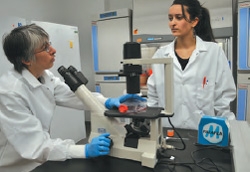 Only a few short years ago, the only way to find out whether a drug might have therapeutic potential for people with a specific disease was to test it first in animals and, if that showed promise, to afflicted humans. Ethical considerations aside, this process is slow, expensive, and risky.
Only a few short years ago, the only way to find out whether a drug might have therapeutic potential for people with a specific disease was to test it first in animals and, if that showed promise, to afflicted humans. Ethical considerations aside, this process is slow, expensive, and risky.
With the advent of cell reprogramming, a new option now exists. Scientists can now take skin cells (and soon, hair or blood cells) from a patient with a disease and, in the laboratory, return those cells to an earlier, embryonic-like (pluripotent) state and create large numbers of them. These disease-specific induced pluripotent stem (iPS) cells—the first of which were created by HSCI researchers in 2008—are valuable tools that, among other existing and potential uses, serve as “diseases in a dish” with which to identify therapeutic targets and screen drugs that might be safe and effective.
As a pioneer in iPS cell technology, in 2008 HSCI established the first iPS Core Facility in the world. Overseen by a committee of HSCI’s cell reprogramming experts, the iPS Core generates new disease-specific iPS cell lines, serves as a repository for HSCI’s existing iPS cell lines, and distributes these valuable resources to scientists worldwide. While top priority is given to HSCI-affiliated scientists, thus far iPS cell lines of multiple diseases have been distributed to scientists throughout North America, Asia, and Europe.
In early 2010, the iPS Core Facility moved from its original quarters at Massachusetts General Hospital to a larger, newly renovated space in the Bauer Building on the Harvard University campus. According to Laurence Daheron, PhD, manager of the iPS Core, the new location offers many advantages. “We have much more space, including five times the bench space, which will enable us to add staff and expand our capacity to meet the growing demand for these cells,” she says. “We also now have three [versus one] separate cell culture rooms, which ensures better quality control” during the many monthslong process of creating a new iPS cell line.
Another advantage is the facility’s close proximity to HSCI’s Therapeutic Screening Center and cell reprogramming experts within Harvard’s Department of Stem Cell and Regenerative Biology. “Because iPS technology is very new, we’re always seeking ways to improve it, so having many of the world’s experts literally right next door is a major benefit,” says Daheron.
